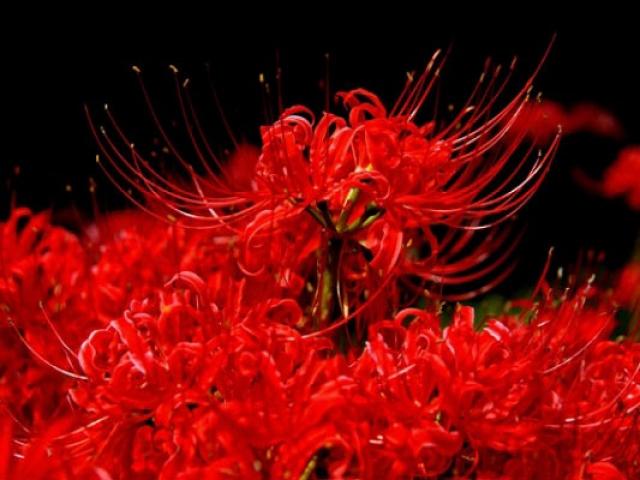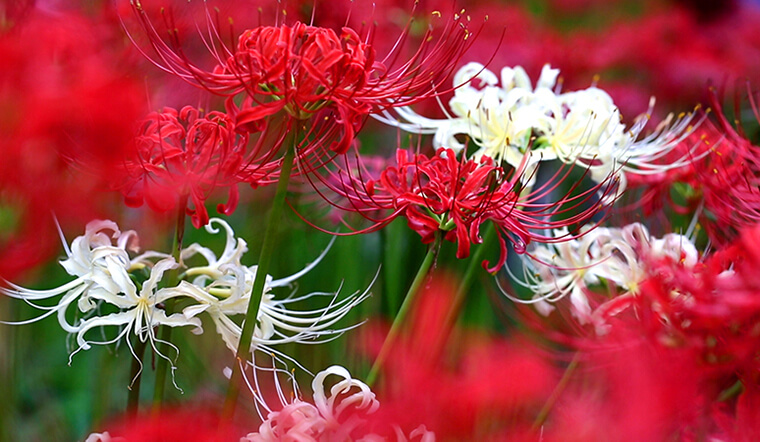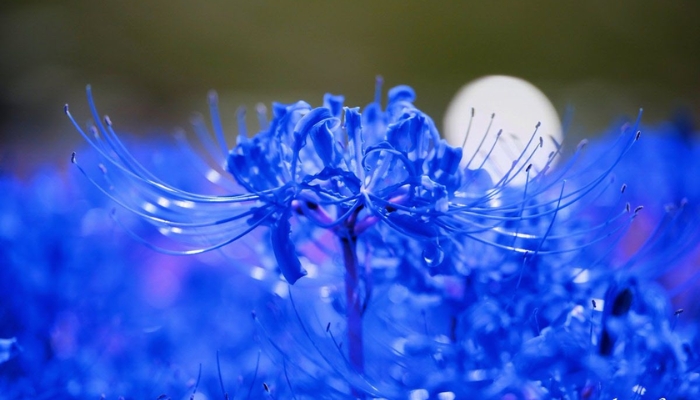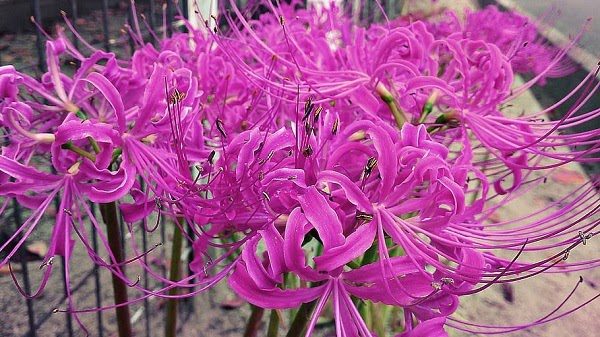

Nature has a way of captivating us with its mesmerizing creations, and the Lycoris radiata, also known as the Spider Lily, is a perfect example of this phenomenon. With its stunning crimson-red petals and unique features, this flower has been cherished for centuries and continues to hold a special place in the hearts of flower enthusiasts and botanists alike. In this blog, we will explore the captivating beauty and intriguing characteristics of the Lycoris radiata, uncovering the secrets that make it a beloved flower around the world.

I. The Origins of Lycoris Radiata
Lycoris radiata, commonly known as the Spider Lily, is a perennial flowering plant that belongs to the Amaryllidaceae family. It is native to East Asia, specifically Japan, China, and Korea, where it has been an integral part of the region’s cultural and botanical heritage for centuries. The name “Lycoris” is derived from a Greek word that refers to a beautiful and passionate young woman, and “radiata” relates to the radiant nature of the flower’s blooms.

A. Red Spider Lily Festival in Japan
In Japan, the Lycoris radiata holds a special place in the hearts of the people and is closely associated with autumn and death. The Red Spider Lily Festival, known as “Higanbana” in Japanese, is celebrated during the autumn equinox when these crimson beauties bloom en masse, often in cemeteries and along riverbanks. This striking display of red flowers symbolizes the fleeting nature of life and is believed to guide the spirits of the deceased to the afterlife.

B. Symbolism in Chinese Culture
In Chinese culture, the Lycoris radiata is associated with transformation and reincarnation. The flower’s vibrant red color is thought to ward off evil spirits and bring good fortune. It has also been used in traditional Chinese medicine for its medicinal properties.

II. Captivating Appearance
One of the most enchanting aspects of the Lycoris radiata is its stunning appearance. The flower’s striking crimson-red petals capture the eye with their vibrant hue. Each flower typically consists of six elongated petals, giving it the appearance of a starburst. This unique shape is often what draws people to the flower and has earned it the nickname “Spider Lily” due to the petals’ resemblance to spider legs.
A. Late Bloomer
The Lycoris radiata has a unique blooming pattern. Its leaves emerge in the spring, then wither away in early summer, leaving behind a barren stem. It is only in late summer or early autumn that the flowers start to emerge, seemingly out of nowhere. This mysterious and delayed blooming adds to the allure of the Spider Lily, creating an air of suspense and excitement for those eagerly awaiting its arrival.
B. Longevity
Despite its late blooming period, the flowers of Lycoris radiata have an impressive lifespan, often lasting for several weeks. Each bloom is a testament to the endurance and resilience of this remarkable plant.

III. Ecological Significance
The Lycoris radiata also plays a significant role in its natural ecosystems. While its mesmerizing beauty is a standout feature, it has other hidden attributes that make it an essential component of local biodiversity.
A. Pollinator Attraction
Like many other flowers, the Spider Lily relies on pollinators to reproduce. Bees, butterflies, and other insects are drawn to its vibrant red petals and sweet nectar. By attracting these pollinators, Lycoris radiata contributes to the pollination of other plants in the ecosystem, playing a crucial role in the local environment’s biodiversity.
B. Adaptation to Seasonal Changes
The delayed blooming of Lycoris radiata is not just a source of fascination; it is also an ingenious adaptation to its environment. By blooming after the summer heat has passed, the Spider Lily avoids competition with other flowers for pollinators’ attention. This unique strategy ensures that it can reproduce efficiently and continue to thrive in its natural habitat.
IV. Cultivation and Care
For those who wish to bring the beauty of the Lycoris radiata into their own gardens, understanding its cultivation and care is essential.
A. Soil and Light
Spider Lilies thrive in well-draining soil and require at least six hours of sunlight each day to bloom successfully. They are also known to tolerate partial shade, making them a versatile choice for various garden settings.
B. Planting Depth
To plant Lycoris radiata bulbs, you should place them about 2-4 inches deep in the soil. These bulbs should be spaced 6-8 inches apart to allow for proper growth and ensure that the plants do not become overcrowded.
C. Watering
Lycoris radiata prefers moderately moist soil, so regular watering is essential. Water your Spider Lilies consistently throughout their growing season and ensure that the soil doesn’t become overly dry or waterlogged.
D. Fertilization
Fertilizing your Spider Lilies once or twice a year with a balanced, all-purpose fertilizer can help promote healthy growth and vibrant blooms. It’s best to fertilize in the spring, just as the leaves are emerging, and again after the flowers have withered.
E. Winter Protection
In areas with harsh winters, it’s advisable to mulch the area where your Lycoris radiata is planted to protect the bulbs from freezing temperatures. This will help ensure their survival through the cold season.
V. Cultural Significance
Beyond its ecological role and captivating beauty, Lycoris radiata holds cultural significance in various parts of the world.
A. Art and Literature
The Spider Lily has been a recurring motif in Asian art and literature for centuries. Its vibrant red petals are often featured in paintings, poems, and other forms of artistic expression, symbolizing themes of beauty, transience, and the passage of time.
B. Symbol of Rebirth
In addition to its role in commemorating the deceased, the Lycoris radiata is also seen as a symbol of rebirth and renewal. Its late blooming schedule and the fact that it emerges from barren stems have led to its association with transformation and new beginnings.
C. Traditional Medicine
In Chinese traditional medicine, the Lycoris radiata has been used for its medicinal properties. It is believed to have various healing properties, and different parts of the plant have been used to treat ailments ranging from swelling and pain to respiratory issues.
VI. Varieties and Hybrids
While the classic Lycoris radiata is known for its striking red blossoms, there are several other captivating varieties and hybrids to explore.
A. Lycoris Albiflora
Lycoris albiflora, or the White Spider Lily, is a variety with pure white petals. This variation offers a serene and elegant alternative to the traditional crimson-red Spider Lily.
B. Lycoris Sprengeri
Lycoris sprengeri, also known as the Sprenger’s Spider Lily, features vivid pink or magenta blossoms. Its striking color makes it a captivating addition to any garden.
C. Hybrid Varieties
Hybrid varieties have been developed by crossing different Lycoris species to create new and unique colors and forms. These hybrids often combine the captivating beauty of the Spider Lily with the traits of other Lycoris species, resulting in a wide range of options for garden enthusiasts.
